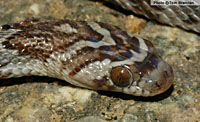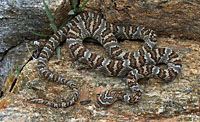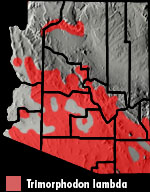Online Field Guide to The Reptiles and Amphibians of Arizona


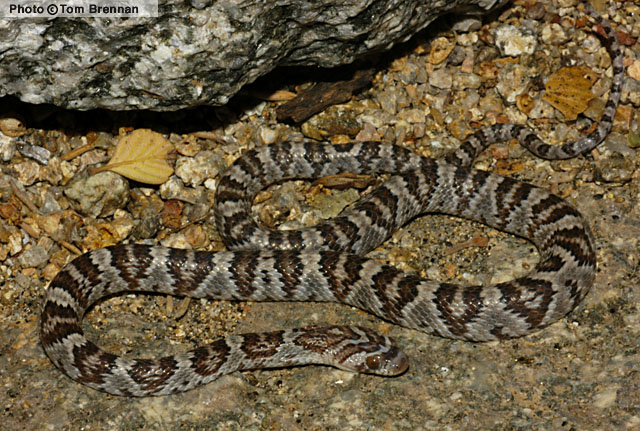
Yavapai County, AZ
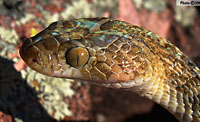 Santa Cruz Co., AZ |
| SONORAN LYRESNAKE Trimorphodon lambda |
Mildly Venomous
|
| DESCRIPTION: A medium sized (up to 1,026 mm or 40″ in total length) light gray-brown to gray snake with a prominent dark brown lyre-shaped marking on the top of the head and a dark bar crossing the top of the head between the eyes. There are fewer than 30 (an average of 24) dark, orange-brown, jagged-edged blotches on the back. Each dorsal blotch is outlined in pale gray and divided by a pale-gray central crossbar. Small dark additional markings are present on the sides of the body between the primary blotches. The head is broad posteriorly and is clearly distinct from the slender neck. The eyes are large and the pupils are vertically elliptical. The underside is light cream, yellow, or gray, occasionally with sporadic dark brown flecking. The scales are smooth. DISTRIBUTION: This snake is found across nearly all of southern Arizona and is likely found in most ranges in the western part of the state. Populations (possibly isolated) have been documented in the lower Grand Canyon, The Black Mountains of Mohave County, and the Kofa mountains of Yuma County. In Arizona this snake occurs at elevations ranging from just a few hundred feet above sea level to over 5,000′. HABITAT: It is found in a variety of biotic communities in Arizona including Sonoran, Mohave, and Chihuahuan desertscrubs, Semidesert Grassland, Interior Chaparral, Great Basin Conifer Woodland, Madrean Evergreen Woodland, and the lower reaches of Petran Montane Conifer Forest. It is usually encountered in rocky habitat above the flats. It frequents boulder-strewn hillsides, steep slopes, and rocky canyons. BEHAVIOR: This snake is nocturnal but it can be found basking in sun-warmed rock crevices on warm days in spring and fall. It hibernates during the cold months of late fall and winter. It is chiefly a ground-dweller but is capable of climbing. Although this snake usually does not bite when captured it is capable of injecting mild venom with enlarged, grooved teeth in the rear portion of its upper jaw. Bites to humans reportedly cause mild swelling and irritation. DIET: The Western Lyresnake uses its venom to subdue lizards, small mammals, bats, and birds. It also has the ability to constrict its prey. REPRODUCTION: A clutch of up to 20 eggs is laid in late summer. REMARKS: The Sonoran Lyresnake apparently hybridizes with the Chihuahuan Lyresnake (Trimorphodon vilkinsonii) in extreme southeastern Arizona and southwestern New Mexico. Brennan, T. C., and A. T. Holycross. 2006. A Field Guide to Amphibians and Reptiles in Arizona. Arizona Game and Fish Department. Phoenix, AZ Brennan, T. C., and A. T. Holycross. 2005. A Field Guide to Amphibians and Reptiles of Maricopa County. Arizona Game and Fish Department. Phoenix, AZ Degenhardt, W. G., Painter, C. W., and Price, A. H.. 1996. Amphibians and Reptiles of New Mexico. University of New Mexico Press. Albuquerque. Devitt, T.J., T.J. LaDuc, and J.A. McGuire. 2008. The Trimorphodon biscutatus (Squamata: Colubridae) Species Complex Revisited: A Multivariate Statistical Analysis of Geographic Variation. Copeia (2) 370-387. Fowlie. 1965. The Snakes of Arizona. Azul Quinta Press, Fallbrook, California Lowe, Schwalbe, Johnson. 1986. The Venomous Reptiles of Arizona. Nongame Branch Stebbins. 1985. Western Reptiles and Amphibians. Houghton Mifflin. New York, |
|
Visit Partners in Amphibian and Reptile Conservation:


HOME
Copyright © 2023, Arizona Game and Fish Department. All rights reserved.
If you make use of the textual contents of this site in reports, publications, etc. please cite and credit the author(s) and photographer(s). All photos on this website are copyrighted. However, those found in the species account section may be used for any noncommercial scientific, educational, or conservation purposes provided that photographs are not altered and continue to bear the copyright symbol and name of the photographer. Please contact the photographer regarding commercial use of copyrighted photographs.










